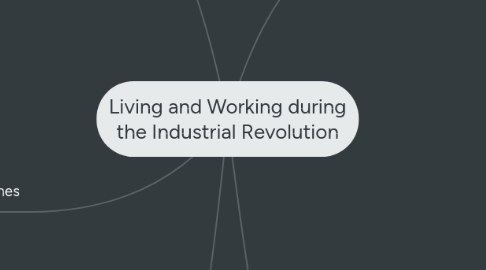
1. Life for workers in 1850
1.1. Growth of cities
1.1.1. 25% lived in cities -> 50%
1.1.2. Small farmers and labourers moved due to enclosure
1.1.3. Domestic system couldn't compete with factory system, moved to cities too
1.1.4. City size increased hugely
1.2. Living conditions
1.2.1. Single room in a large house
1.2.2. Up to 100 people in a twelve room house
1.2.3. Little furniture
1.2.4. Slept on straw
1.2.5. No running water
1.2.6. Open drains in streets - rats
1.2.7. Polluted, smoky air
1.2.8. Bread, cheese, porridge and potatoes
1.3. Diseases
1.3.1. Typhoid
1.3.2. Tuberculosis
1.3.3. Cholera
1.4. Leisure
1.4.1. Sundays off
1.4.2. Drank heavily
1.4.3. Gambling
1.4.4. Cock fighting
1.4.5. Dog fighting
1.4.6. Bare knuckle fighting
1.4.7. From 1850 onwards:
1.4.7.1. Saturdays were a half day
1.4.7.2. Football Association introduced rules
1.5. Education
1.5.1. 1800, very few working class children attended school
1.5.1.1. Worked in factories or mines
1.5.1.2. Family needed their wages
1.5.2. Factory Act, 1833
2. Working conditions in textile mills
2.1. Mills, deafening noise, five storeys
2.2. Dust, caused lung disease
2.3. Hot, damp air - so threads wouldn't break
2.4. 5:30am - 8pm, 6 days a week
2.5. Wages low
2.6. More women and children than men
2.7. Children worked
2.8. Fined for "offences"
2.9. Injuries / death due to tiredness and unprotected machines
2.10. Piecers, often resulted in serious injury
2.11. Children beaten if not working fast
2.12. Backs deformed from bending all day
2.13. Clothes covered in water, froze in winter
3. Working conditions in coal mines
3.1. Fourteen hours a day
3.2. Dark, damp conditions
3.3. Trappers, very young
3.4. Hurriers, 8 years old
3.5. Colliers, at 17 years old
3.6. Effects
3.6.1. Miner's lung
3.6.2. Crooked backs
3.6.3. Poor eyesight
3.6.4. Killed by floods, explosions, cave-ins
4. Reforms
4.1. Robert Owen
4.1.1. Treated workers well
4.1.2. Made large profit
4.1.3. Some followed
4.1.4. Most didn't
4.2. The Chartists
4.2.1. Aimed to increase number of middle-class men with the right to vote
4.2.2. Huge rallies and petitions
4.2.3. Government ignored, movement failed
4.3. Lord Shaftesbury
4.3.1. Dramatically improved working conditions
4.3.2. Government afraid of revolution
4.4. Edwin Chadwick
4.4.1. Said dirty water and bad drains caused cholera
4.4.2. Put pressure on government
4.4.3. Recommended every city have a sewage system
4.4.4. Public Health Act, 1848
4.4.4.1. After a cholera epidemic
4.4.4.2. Stated that sewers and water pipes be built
4.4.5. Cities became cleaner, health improved
5. Factory owners
5.1. Lived in countryside, away from pollution
5.2. Large house, staff, expensive furniture
5.3. Well educated children
5.3.1. Boys went to university, took over the family business
5.3.2. Girls privately tutored by governess or tutor
5.3.3. Girls' mothers taught them manners, painting and needlework
5.4. Food
5.4.1. Fish
5.4.2. Soup
5.4.3. Chicken
5.4.4. Wine
